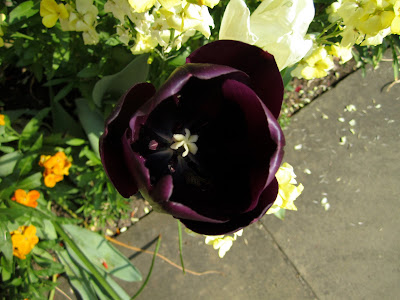I have a little smile on my face as I write this. If I hadn't been to England right before Easter then I wouldn't have been to the airport shop with all the magazines. Magazines in English. Well, it was England after all. If I hadn't been in the shop then I wouldn't have seen a particular cooking magazine. If I hadn't seen that magazine and brought it with me to the checkout counter then I would have never discovered this:
But I did. And halleluah. I haven't been taken with a recipe like this in a looong time. As soon as I saw the photo of the dish and read the ingredient list I said, Ok, I will be making that. And quick. I continue on my bandwagon of desserts that are both super easy and totally divine. And when fruit is a main ingredient the whole thing somehow seems virtuous. As in, I'll have another piece. And another.
You won't believe how easy this is. If you are at all timid about making your own caramel on the stove, just buy a jar of dulce de leche in the store. Or if you are in the U.S. buy a bag of Kraft caramels and get to melting. But honestly, making caramel on the stove is ridiculously easy...and way tastier than anything you can buy.
Here is what you need to do to get started on the tart: Make your go-to pie crust recipe. Don't have one? Surely you can ask your mother, aunt, or trusty neighbor for theirs. If that isn't an option, look in a cookbook or on one of the gazillion cooking websites or blogs. (I love cooking with a passion but even I get overwhelmed by all the sites.) Whatever you do, keep it easy.
Then you are going to get a few bananas. Maybe four, depending on their size. You want firm, yellow bananas. Not hard green ones or the super ripe spotted variety. Slice into fat coins and set aside.
Have your salt and pepper at the ready. I'll explain later. Trust me on this one.
For the caramel: put a 1/2 cup (100g) of white sugar in a saucepan and stir in 2T (2 soup spoons) of water. Stir over low heat until the sugar is melted and the mixture starts to bubble. Turn up the heat to medium and cook for another 3-5 minutes, or until it turns a golden caramel color, swirling the pan gently from time to time to brown evenly. Don't let it burn (although it might smell a bit "too done") but don't undercook either. Remove from the heat, add 1T (1 soup spoon) of water (the sputtering and hardening is normal but will stop quickly), stir, then add 3.5T (50g) of butter. Stir to a smooth sauce and set aside.
To assemble: Pour the caramel in the bottom of a pie plate or tart pan (judge the size of the pan by how much caramel (and banana slices) you have). I used a 9" pie plate and the caramel covered the entire bottom, which is what you want.
Take a couple of big pinches of sea salt and sprinkle all over the caramel. Then scatter over a few pinches of black pepper or grind right onto the bananas. Leave to cool for a few minutes and then add the banana slices, pressing them into the caramel and pushing them together to fill the gaps.
Roll out your pie crust to the diameter of the pie plate, as thick or perhaps a little thicker than a coin (but not quite as thick as your banana slices). Place the pastry on top of the bananas and press down; tuck in the edges so it forms a sort of upturned bowl over the bananas. Prick the pastry with a fork.
Bake at 375F or 200C for 20-25 minutes or until golden brown. Leave to cool for 10 minutes, then run a knife around the edge, place a large plate over the top and carefully invert the tart onto the plate. You might need to reposition some banana slices. Be careful of the hot caramel. Serve warm or cold.
I ate it plain but it would also be nice with vanilla ice cream or whipped cream.
Adapted from Lucas Hollweg's Good Things to Eat.
Friday, May 20, 2011
Monday, May 16, 2011
Say it with me: Rød Grød Med Fløde
When I moved to Denmark three years ago I was horrified when a fellow Danish language student tried to get me to pronounce Rød Grød Med Fløde. I beg your pardon? If you've been in the country for any length of time then surely you've heard of this classic Danish dessert with the mumble jumble name. Alas, ‘red porridge with cream’ just doesn't have the same ring to it. Titles and translations aside, early summer is the perfect time to prepare this bright red, fruity concoction drizzled with cream.
I owe my encounter with it to my friend Gitte who--as a Dane living in the U.S. and a food blogger to boot--is my mirror opposite. Gitte sold me on Rød Grød Med Fløde, and I'm forever grateful. This dessert is as delicious as it is beautiful. It's simple enough to eat by the spoonful right out of the pan but elegant enough to serve at a fancy dinner party.
This time of year the markets are teeming with seasonal fruit, especially strawberries. I even found a small basket of lovely Danish strawberries in among those from Spain and Belgium. The other seasonal fruit that is a splendid match for the berries in this dish is rhubarb. I love the stringy tart stalks, but some don't. If you are put off by it, either because of texture or taste, please don't be. All it takes is a little sugar, heat, and commingling with other fruit and you have a scrumptious treat. What's more, rhubarb adds a wonderful flavor boost to cobblers and pies. Celebrate the underrated rhubarb.
The recipe for Rød Grød Med Fløde is relatively effortless and can be assembled in a matter of minutes. The most difficult step is saying the name (see paragraph 1) and waiting for the mixture to cool in the refrigerator.
Recipe adapted from My Danish Kitchen
Ingredients
2 medium stalks rhubarb, cut into small pieces
200g fresh raspberries (small basket, about 1.5c)
200g fresh strawberries (about 1.5c)
1/2c...125ml sugar
1c...250ml water
3T...3 soup spoons cornstarch
5T...5 soup spoons water
Directions
1. Toss washed fruit together in a saucepan. Add sugar and water and set saucepan over medium heat. Stir occasionally until mixture just comes to a boil.
2. Turn heat down to low and simmer for 15 minutes or until fruit has broken down.
3. Meanwhile, mix together cornstarch and water in a small dish and set aside.
4. Remove fruit mixture from heat and pour into a sieve which has been set over a bowl.
5. Use a spoon to scrape the seeds and pulp against the sieve, catching the juice in the bowl. (it's okay if a little pulp gets into the juice).
6. Set the pulp aside. You can save it for later as a topping for yogurt or pancakes.
7. Return saucepan to medium heat and slowly add cornstarch mixture, spoon by spoon.
8. Stir constantly until mixture thickens and can coat the back of a wooden spoon.
9. Remove from heat and pour into individual serving dishes or a medium glass bowl.
10. Let cool for 10 minutes and then refrigerate for at least one hour. Serve with cream or milk.
Wednesday, May 11, 2011
Now where was I
Shortly before Easter I attended a teachers' workshop at Oxford University. It was an intense two and a half days of work, but I managed to have a peek around the city under warm and sunny British skies. It was my second trip to Oxford more than 10 years after my first where, as part of a mini European tour, I spent a weekend with my friend Sonja who was on an exchange from Georgetown University.
In my best British accent, I must say that Oxford is lovely. Simply charming. Not dreadful in the least. I love the way the Brits talk. Much more refined than us rough and tumble Americans.
The food--as least in my experience--is rather underwhelming. My sense is that good food is to be had in Oxford, but the extent of my foray into the local culinary scene has been dining halls, cheap eateries, and supermarkets. Take the dinner I had on my one free night of the workshop. Following nearly two hours touching, breathing in, and practically consuming the wares in Blackwell's Bookshop, I stopped at the Tesco for sushi, fruit, chocolate, and a small bottle of red wine. I then went back to my room, ate at my desk and indulged in another guilty pleasure: People Magazine.
The atmosphere at Oxford is inspiring enough to write one's first novel. Instead, I ate chocolate and read People. You also can bet that I loaded my suitcase with as many American magazines as I could get my hands on as well as a few books from Blackwell's. I'll save those for when I'm feeling slightly more intellectual.
In my best British accent, I must say that Oxford is lovely. Simply charming. Not dreadful in the least. I love the way the Brits talk. Much more refined than us rough and tumble Americans.
The food--as least in my experience--is rather underwhelming. My sense is that good food is to be had in Oxford, but the extent of my foray into the local culinary scene has been dining halls, cheap eateries, and supermarkets. Take the dinner I had on my one free night of the workshop. Following nearly two hours touching, breathing in, and practically consuming the wares in Blackwell's Bookshop, I stopped at the Tesco for sushi, fruit, chocolate, and a small bottle of red wine. I then went back to my room, ate at my desk and indulged in another guilty pleasure: People Magazine.
The atmosphere at Oxford is inspiring enough to write one's first novel. Instead, I ate chocolate and read People. You also can bet that I loaded my suitcase with as many American magazines as I could get my hands on as well as a few books from Blackwell's. I'll save those for when I'm feeling slightly more intellectual.
Subscribe to:
Posts (Atom)



































